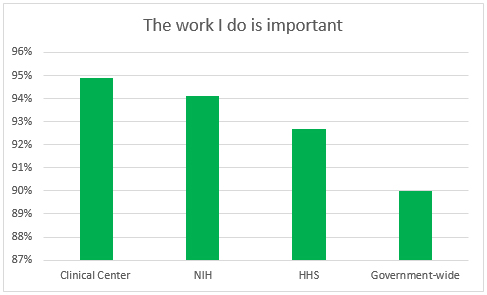Employee Survey Notes Positives, Potential Improvements for the Clinical Center
Over 1,000 of Your Colleagues in the Clinical Center Spoke Out: What Did They Have to Say?
The results are in. Over 1,000 staff at the NIH Clinical Center shared their thoughts in the 2019 Federal Employee Viewpoint Survey (FEVS) and these opinions are making a difference.
What is the Federal Employee Viewpoint Survey (FEVS)?
The FEVS measures employees' perceptions of their work experiences, organizations and leaders. The survey results provide valuable insight for Clinical Center leaders on how their staff feel they are managing challenges in the workplace.
All full, part-time and non-seasonal federal employees, including Title 42 and Commissioned Corps, who were onboard on or before October 27, 2018 were eligible to participate in the 2019 survey.
Eligible staff receive the survey individually via email and responses are collected anonymously to ensure honest feedback. Clinical Center departments with sections that have ten or more respondents receive data for those sections. Results are also assessed on global satisfaction and employee engagement scores.
Accountability Tool
Dr. James Gilman, the Clinical Center CEO, meets with all department heads to review their FEVS results in person. The Clinical Center's Office of Workforce Management and Development creates a dashboard of each department's results that provides analysis on their top ranked and bottom ranked items; the most improved and declined items compared to the previous year; and flagging the items that scored furthest above and below the Clinical Center average.
How departments use their FEVS data differs. For example, the Office of Administrative Management used focus groups to dive deeper into some of the most important issues and then used that data to create several working groups that are currently working on new initiatives. These initiatives include a peer-to-peer partnership program, new core value employee recognition awards and more standardized processes across OAM.
"The FEVS is helping me as a leader in OAM to see what my team needs, what ideas come from the team, and ultimately what areas we can provide help to make the workdays more manageable for the Administrative Officers (AOs)," said Lula Russell, Acting Chief of the Office of Administrative Management.
"The FEVS provided a roadmap for me to see where we need to get help for our AOs and how we can help guide them to ensure our office remains efficient and engaged."
More People Getting Involved
In 2019, a record number of Clinical Center employees (62%) completed and submitted their FEVS surveys. This continued an upward trend in participation.
| Year | Participation Rate |
|---|---|
| 2019 | 62% |
| 2018 | 61% |
| 2017 | 56% |
| 2016 | 40% |
One especially exciting outcome was that there was double-digit participation increases by certain Departments this year, likely due to increased engagement.
"The FEVS complements several employee communication strategies already underway to help improve the Clinical Center," said Dr. James Gilman.
"Every employee can make an important contribution to the Clinical Center by engaging management in honest and constructive feedback," Gilman said. "We want to hear from all of you to help us make informed management, operational and workplace quality changes and move the Clinical Center towards performance excellence in all areas."
Top Ratings
Federal staff at the Clinical Center rated many components highly. Here were the top three items from the 2019 survey:
- When needed I am willing to put in the extra effort to get a job done. (97.3% selected this response)
- The work I do is important. (94.9%)
- I am constantly looking for ways to do my job better. (92.6%)
The question "the work I do is important" stood out. While it wasn't the hospital's top score in the survey, the Clinical Center's response to this question surpassed the average for all of NIH, as well as the average for the Department of Health and Human Services (HHS) and the entire federal government.

Some areas also need more work. Here were the lowest three items from the 2019 survey:
- Pay raises depend on how well employees perform their jobs. (35.7% selected this response)
- Considering everything, how satisfied are you with your pay? (30.2%)
- I have sufficient resources (for example, people, materials, budgets) to get my job done. (30%)
These responses have been the hospital's lowest for several years and are generally low across the board for federal employees due to little control over pay and other federal regulations. Nonetheless, the Clinical Center continues to work on these issues through training for supervisors and providing more opportunities for employee development.
Belief in Action Indicator
Of biggest concern, the item stating, "I believe the results of this survey will be used to make my agency a better place to work" (also known as the Belief in Action Indicator) decreased by 3.4%, after having improved by 8% in 2018. As Dr. Gilman stated in his January Town Hall meetings, he takes the FEVS results very seriously, and works very closely with each Department Head to ensure they are working on action plans to address their specific results. The FEVS is an important tool that Clinical Center leaders examine closely and can have a major impact on how the hospital operates.
The FEVS for 2020 will run from Sept. 21 to Nov. 2. Keep an eye on your inbox for more details and add your voice!
For more information on the FEVS, including the full Clinical Center results, visit the Office of Workforce Management and Development's Federal Employee Viewpoint Survey webpage (staff only).